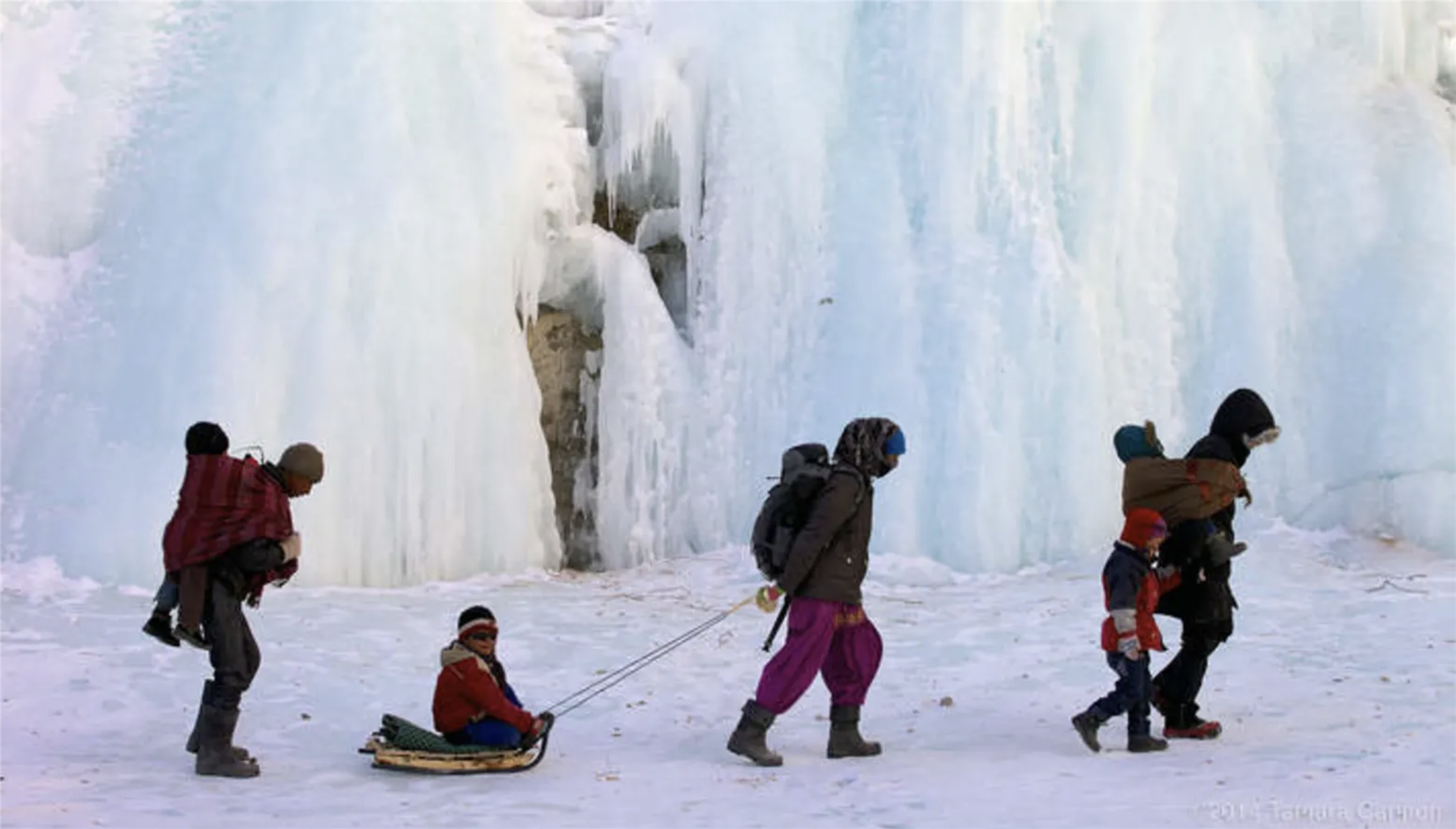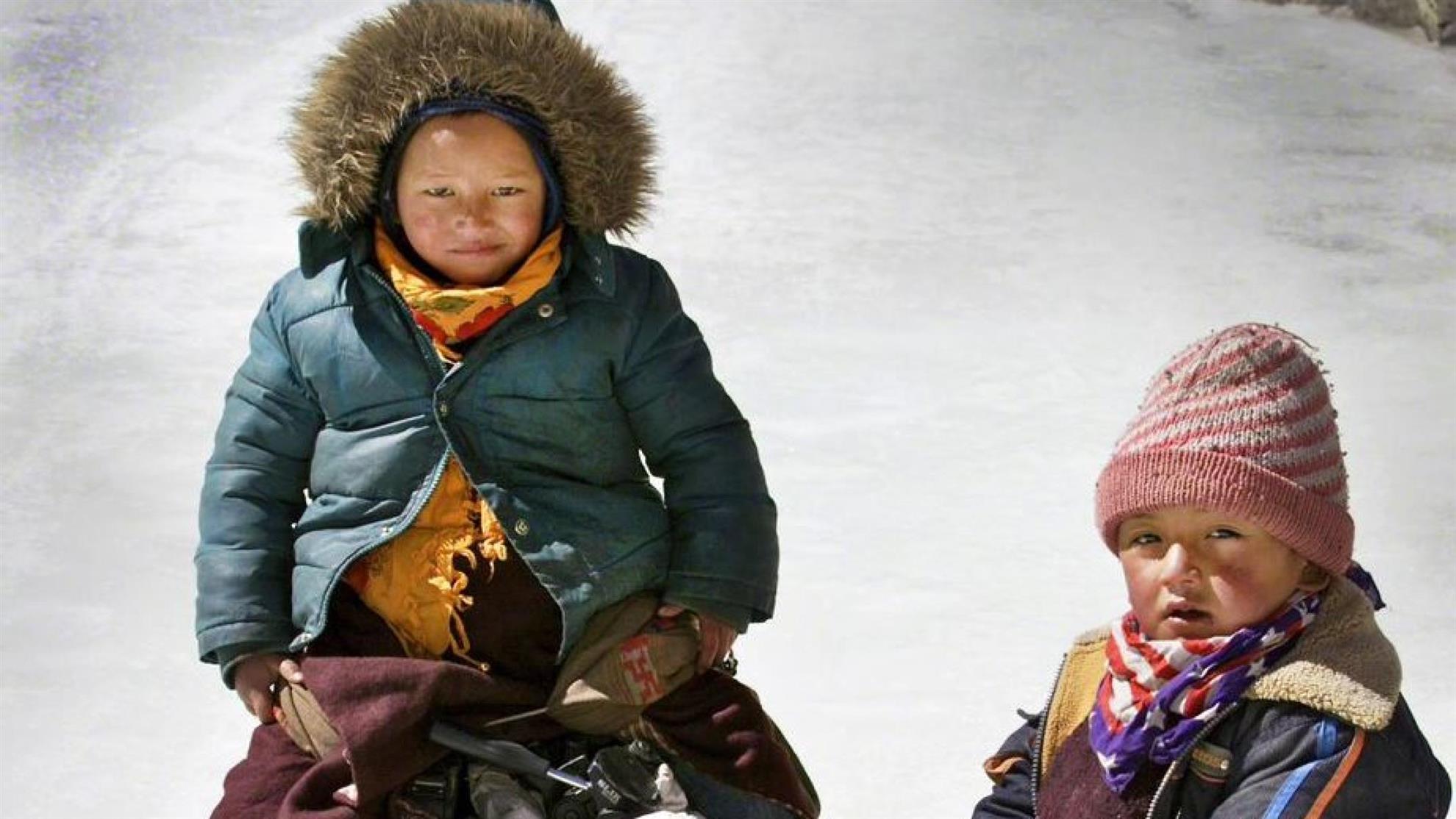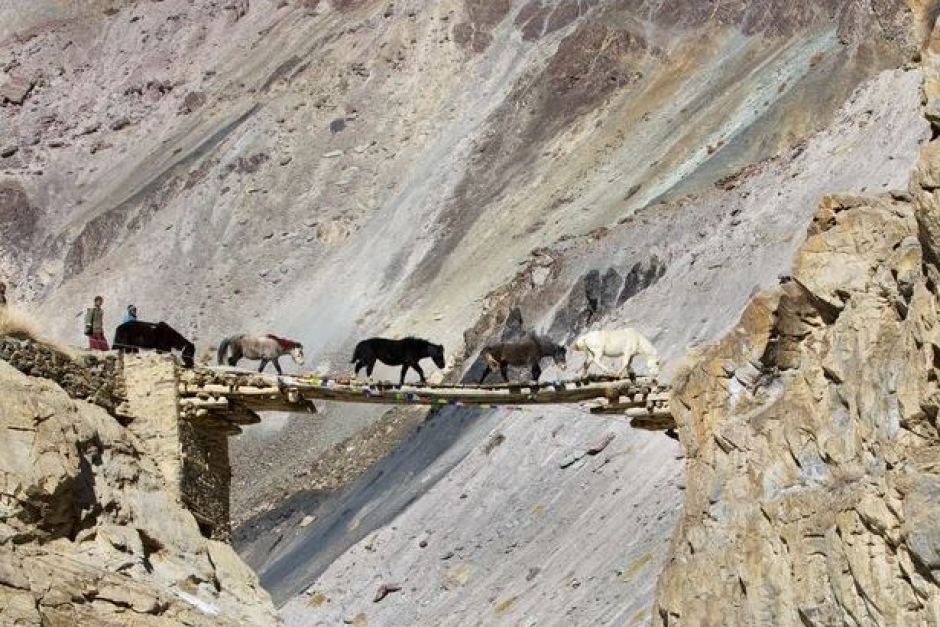 In the Indian Himalayas, children may no longer have to risk their lives simply getting to school, thanks to the efforts of one Australian woman.
In the Indian Himalayas, children may no longer have to risk their lives simply getting to school, thanks to the efforts of one Australian woman.
This story by John Zubrzycki was published by "The Age" on May 17, 2014
Tanzin Tsewang goes first, testing the ice with a stout piece of willow. Last night's snowfall has made walking on the slippery surface easier, but it also masks its weak points. Upstream, an angry Zanskar River has torn through the ice, forcing us to make a risky crossing to the opposite bank. With each step, Stanzin's foot sinks into the slush before settling on the still frozen subsurface. One mistake could mean drowning in the fast-flowing, near-freezing waters of this tributary of the mighty Indus in northern India.
Watching closely, 40-year-old Australian Tamara Cannon lifts her pack, adjusts her crampons and prepares to follow local guide Stanzin's watery trail. She is less worried about the river racing just centimetres below her feet than she is about one of her students, 17-year-old Sonam Tundup*, who is walking down the Zanskar valley along what the local people call the Chadar, and should have reached this point by now.
Six years ago, Cannon dropped a career in corporate law to start Lille Fro, an education and development charity working in the Ladakh region of the Indian Himalayas. Her "office" is one of the remotest on the planet, a vast, sparsely populated, high-altitude desert wedged between Pakistan and China, and her clients include nomads, disaster victims and children desperate for an education.
Today's "commute" is along a Himalayan highway, which for three months during winter is the only route linking the remote Zanskar district with the outside world. Chadar means "veil" or "blanket", and to undertake the Chadar Trek means to walk on the blanket of ice that transforms the Zanskar River, turning it into a lifeline not just for traders but for children who leave their snow-bound villages at the end of wi nter to go to Leh, Ladakh's capital, for their education.
nter to go to Leh, Ladakh's capital, for their education.
Photo: Whiteout: Children being accompanied to school along the Chadar. CREDIT:TAMARA CANNON
The Chadar has been called the world's most dangerous walk to school, and today Cannon is worried that it might live up to its reputation. It is early March, just days before term starts, and the spring thaw is starting to melt the ice. We have already waded through a bend of the river and clambered up cliff faces because the ice has given way. The locals do it with sleds strapped to their backs and babies on their shoulders. I'd expected the Chadar to be an 80-kilometre-long skating rink with views to die for. In reality, it is a malevolent blue monster constantly looking for weaknesses in the ice and changing course at a whim. We think Sonam spent the night in a cave near Nerak, the only village along the route. He should have covered the remaining 40 kilometres in eight hours. Cannon fears he might be trapped between two sections of broken ice or been forced to return, which would mean missing months of school before the jeep track that links Zanskar with Leh reopens in late spring.
So far the only people we have seen were two distant campers on the other side of the river near the road head. "It's very strange," Cannon says. "We should have seen someone coming down the river by now."
Cannon met Sonam in 2008, when she visited Zanskar for the first time. His mother died when he was just one. His father is a labourer who supplements what little money he makes by working in the fields and selling cow dung to neighbouring villages.
As Stanzin sets off to reconnoitre what lies around the next bend, Cannon unwraps her scarf, pours some tea fro m a thermos and pokes fun at my dust-covered clothes from my less-than-elegant descent down a particularly steep river bank.
m a thermos and pokes fun at my dust-covered clothes from my less-than-elegant descent down a particularly steep river bank.
Photo: Big chill: One ill-timed step could mean death in the icy waters. CREDIT:MATT GALBALLY
When we first met some months earlier at a restaurant in Sydney's Surry Hills, Cannon had come across as quietly reserved. She confessed to being uncomfortable as a public speaker - which she conceded was an essential element of her charity's fundraising activities - and warned of the dangers of traditional Ladakhi cuisine, which in the winter consists of dried meat in a tasteless broth guaranteed to test the strongest of stomachs.
Yet when we boarded the plane from New Delhi to Leh and squeezed into a row of excited Ladakhis, Cannon relaxed immediately. The cabin smelt of yak wool, soot and sweat, and many of the passengers had clearly never been on a plane before. Then, when we landed, Cannon seemed to know everyone at the airport, from the manager to the police. Shouts of "Tamara-lay!' and "jullay" - the traditional Ladakhi greeting - followed us, her blonde hair and vivid blue eyes a beacon beneath multiple layers of mountain gear.
Cannon grew up in Melbourne and went to Monash University, where she did a combined arts/law degree. She preferred languages to studying the Corporations Act, but eventually opted for a legal career. Asked by her law firm, Freehills, to go to Sydney to work on a project, she decided to make the city her home, later becoming a senior corporate counsel for some of Australia's largest companies.
Starting a charity wasn't a conscious decision. "I felt as if I had stopped learning, like I was treading water," she says. "I took some time off from law and was working on a business idea in Hong Kong.
Photo: Into the wild: Families risk their lives crossing the river.
CREDIT:TAMARA CANNON
"Not having a desk job to go back to, I thought I could go anywhere. So I closed my eyes and put a finger on a map, and it landed on Mount Everest. I thought, 'Oh, I didn't see that coming.' Then I thought, 'Why not?' "
Cannon bought some hiking boots and made the trek to Everest Base Camp. "I was hopeless at this altitude business, but thought I'd like to climb a peak and was pointed in the direction of Ladakh."
While on her climb, Cannon met a village girl who had never been to school and decided to pay for her education. Seeing the difference education made to the girl's life encouraged Cannon to set up Lille Fro to help other children.
Compared with much of India, Ladakh is an education success story. There is not a single village without a school. But the raw statistics tell only part of the story. Schools in very remote areas are often staffed by under-qualified teachers. In very poor families, children work in the fields rather than attend classes. Many nomadic families miss out altogether.
"Education was a priority we identified very early on for Lille Fro," says Cannon. "It's such a basic human right for any child and has a powerful effect not only on the child, but also the family and village in terms of breaking that cycle of generational poverty. We work closely with local government and village leaders to help identify communities where the traditional education model is not working effectively for various reasons."
Cannon's commitment to her work has won the respec t of the local authorities. She is reportedly the only foreigner granted access to restricted areas along the disputed border with China and home to some of India's poorest nomadic communities.
t of the local authorities. She is reportedly the only foreigner granted access to restricted areas along the disputed border with China and home to some of India's poorest nomadic communities.
In 2012, she embarked on a two-week expedition into Zanskar to document the journey along the Chadar to raise funds for a local boarding hostel. In the winter months, high-altitude villages are isolated by heavy snow, and people subsist on inadequate diets and lack access to basic education and healthcare.
As a result of her efforts, last year Lille Fro received a large donation from a Melbourne family to fund a hostel near Padum, Zanskar's capital, so children could attend local schools instead of undertaking the risky walk down the Chadar. Punchok Tashi, Zanskar's executive councillor, welcomes the initiative. "Zanskar is cut off for six months of the year, which means no economic activity. We can't do anything about the climate; education is our main priority."
Leh is dominated by a five-storey mud-brick palace that would not look out of place in Lhasa. The mainly Buddhist town was one of the main trading posts on the southern branch of the Silk Route that connected Europe with the Far East.
The caravanserais (roadside inns) where traders from Kashgar and Samarkand once bedded down have been replaced by guesthouses and souvenir shops. Young Ladakhi men saunter down the street in low-slung jeans, bomber jackets and Bollywood hairstyles, mixing with wrinkle-faced monks carrying prayer wheels and amulets. Buddhist prayer flags adorn most houses and white-washed stupas break the monotony of the khaki-coloured landscape.
Ladakh's fairytale quality came to an abrupt end on the night of August 6, 2010, when the worst cloudburst in living memory deposited more rain in 45 minutes than the semi-arid region usually receives in several years. A tsunami of rocks, mud and animal carcasses swept through Leh and the surrounding villages, obliterating homes and destroying infrastructure. The official death toll was 660, but locals believe that thousands of unregistered migrant labourers also perished in the disaster.
Cannon recalls being woken by rain pouring in through her guesthouse roof and seeing poplar trees bent double, the landscape illuminated by constant lightning flashes. When dawn broke, she mobilised as many foreign tourists as possible to help dig out schools, hospitals and homes using shovels and their bare hands. She was devastated to discover that one of the young girls she had been helping get through school had died after being swept from her mother's arms by the torrent. Classrooms that a day earlier had been filled with excited children were buried in debris.
The trauma of seeing so much death and destruction, coupled with months of backbreaking work, took a huge toll on Cannon, who returned to Australia physically and mentally broken.
But the floods were a turning point for Lille Fro. "These were utterly tragic circumstances, but ironically they put us on the map," says Cannon. Her work caught the attention of the European media and donations started coming in from countries such as Switzerland and Austria. Now, in addition to its "Little Seeds" program, which sponsors the education of more than 100 children, the charity is funding community greenhouses and a skills training program that is helping villagers grow fresh vegetables over the winter months.
But finding the money for these projects is a constant battle. "Sustainability is a real issue for us," insists Cannon. "You need staff to design, run and monitor the projects and that's where we need help."
As the recess bell rings on the first day of term at one of Lille Fro's partner schools near Leh, the playground erupts in a cacophony of laughter and shouting. Of the 700 students here, half are boarders from distant parts of Ladakh.
Cannon is looking for eight-year-old Tashi Lhamo, who has walked down the Chadar twice. The previous evening we had met her father, Padma Dorjay, a carpenter from a remote mountain village in Zanskar. Padma described being knocked off his feet by a fast-moving slab of ice as he carried Tashi on his back through the river. When we finally find Tashi in one of the year 2 classrooms, she makes light of her fall into the freezing waters. She shyly says a few words in English, taking deep breaths between each sentence, trying to avert our gaze.
Yet in every other respect there's an extraordinary confidence about her. When she says she wants to become a doctor and go back to her village, I take her at her word. "Education must be meaningful. It must respect local values and traditions," Cannon says later. "This is something Lille Fro is committed to upholding by investing in an indigenous program to give kids the practical skills that they can take back to their villages to help improve the quality of lives.
"In some villages I've visited, most families have one member with a disability. I've met children who are blind, crippled and mentally challenged. Some are deaf. I know their names. I know their stories.
"This is the thing. Development is not all black and white. It's complicated. These are real-life scenarios you can't always prepare for and these people are like family. Recently, I received a call telling me one of our youngest students, a four-year-old orphan, had just been diagnosed with AIDS. I couldn't stop crying."
The sun has slipped behind the brittle 5000-metre peaks that rise almost vertically from the Chadar, intensifying the already-bitter cold. If we wait any longer for the missing student Sonam Tundup, we won't make it to the roadhead before nightfall.
As we climb into our waiting car, we feel sick imagining Sonam's disappointment if he turned up at the last moment and saw us leaving.
After driving down the deserted road back to Leh, Cannon says she will return to the Chadar in the morning to find him. Then, suddenly, the headlights illuminate two figures waving us down. One is Sonam, the other his guide. They were the campers we had seen as we set off up the river. We hadn't recognised them and they hadn't been expecting us.
"I love India. It's unpredictable, it keeps me on my toes," Cannon says later, recounting the day's chain of events that led to our chance encounter with Sonam in the dead of night on a thin ribbon of dirt road carved deep into the Himalayas.
I ask her whether she could ever go back to her old day job of boardroom briefings and negotiating acquisitions. "Well, right now I've kind of got my hands full," she replies. "I don't think there's another job in the world that could possibly bring me the same level of joy, to be able to make a real difference in another person's life. The rewards are huge and I feel very lucky."
* Names of children and parents have been changed to protect the identity of Lille Fro's beneficiaries.